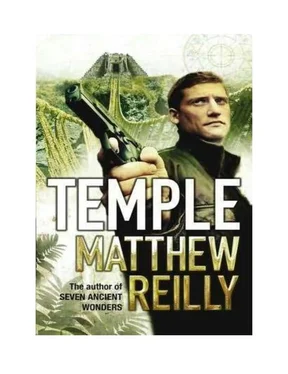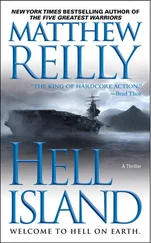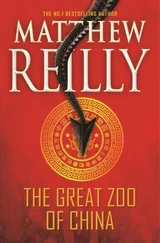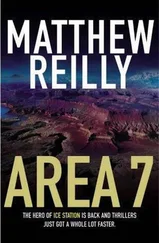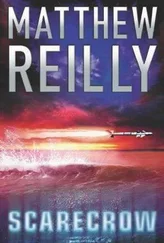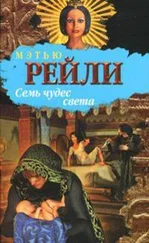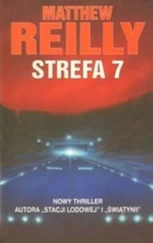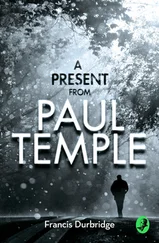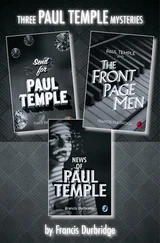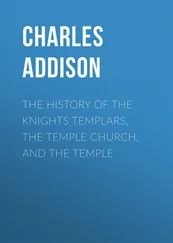It was about nine feet high and completely made of stone. And it was covered in vandalism—-crucifixes and Christian symbols that had been scratched into it by God-fearing conquistadors four hundred years ago.
The stone carving of the rapa, however, was like nothing he had ever seen. It was absolutely terrifying.
It was covered in moisture, dripping with it. And this layer of wetness had a truly strange effect on the carving— it really made it seem as if the stone carving was alive.
Race swallowed hard as he stood before the decrepit old totem.
With the first totem found, the team hurried back to their choppers and lifted off quickly.
Nash’s chopper led the way, flying low over the jungle, in the direction of the rapa’s tail.
Over his headset, Race heard Nash’s voice: ‘—fire up the magnetometer. Once we get a reading on the next totem, we’ll revert to spotlights—”
‘Got it’
Race frowned. He wanted to ask someone what a magnetometer was, but he didn’t want to look any more ignorant in front of Lauren than he already did.
‘It’s a device used by archaeologists to detect relics buried underground,’ Lauren said, smiling wryly at him.
Damn it, he thought.
‘They’re also used commercially by resource exploration companies to detect subterranean reserves of oil and uranium ore,’ she added.
‘How do they work?’
‘A caesium magnetometer like the one we’re using here detects minute variations in the earth’s magnetic field— variations that are caused by objects interrupting the upward flow of that magnetic field.
Archaeologists in Mexico have been using magnetometers for years to find buried Aztec ruins. We’re using ours to find the next stone totem.’
‘But the totems are on the surface,’ Race said. ‘Wouldn’t there be a problem with the magnetometer picking up trees and animals?’
‘It can be a problem,’ Lauren said. ‘But not here. Nash will have set his reader to detect only objects of a certain density and depth. Trees have a density of only a few thousand megabars, and animals, since they’re made of flesh and bone, are even less than that. Incan stone, however, is about five times as dense as the thickest tree in the rainforest—’
‘All right, people,“ Nash’s voice said suddenly. ‘I’ve got a reading. Dead ahead. Corporal, the spotlight.’
And so it went.
For the next hour, as the light faded and the shadows from the mountains grew longer and colder, Race listened as Nash and Chambers and Lopez spotted totem after totem.
After the magnetometer found each totem, they would hover their Huey over it and illuminate it with the chopper’s blinding white spotlight.
Then, depending on which totem they had spotted, they would either go in the direction of the rapa’s tail or to the creature’s left, in the direction of the Mark of the Sun.
The two helicopters flew north, alongside the massive step-like tableland that separated the mountains from the rainforest.
Just as dusk was setting in, Race heard Nash’s voice again.
“All right, we’re coming up on the tableland,’ he said. ‘I can see a large waterfall flowing over it…’
Race got up from his seat and moved forward, looked out through the forward windshield of his helicopter. He saw Nash’s Huey rise up over a magnificent waterfall that marked the edge of the tableland.
“All right… Following the river now…”
The day grew darker and soon all Race could see were the red tail-lights of Nash’s helicopter in front of him, banking and tilting as the Huey followed the path of the wide, black river beneath them, the beam of its spotlight playing over the wavelets on the water’s surface. They were heading west now, toward the wall of mountains that towered above the rainforest.
And then abruptly Race saw Nash’s chopper bank sharply to the right and round a thickly-forested bend in the river.
“Wait a second,’ Nash’s voice said.
Race peered forward through the windshield. Nash’s chopper began to hover above the riverbank to his right.
‘Wait now… I see a clearing. It seems to be covered over with grass and moss but… Wait, there it is. Okay, people, I can see it. I can just make out the ruins of a large pyramid-shaped building…
Looks like the citadel. All right, stand by. Stand by for landing.’
At the very same moment that Nash’s Hueys were landing at the town of Vilcafor, three other—much larger—military aircraft were arriving at Cuzco airport.
They were aeroplanes—-one giant C-17 Globemaster III cargo plane and two small F-14 fighters, the big cargo plane’s escorts. The three planes taxied quickly to a halt at the end of the landing strip, where they were met by a cluster of other aircraft that had arrived at Cuzco only minutes earlier.
Three massive CH-53E Super Stallion helicopters stood at the end of the runway, waiting for the Globemaster. The Super Stallions made for an imposing sight—big and strong, they were the fastest and most powerful heavy lift helicopters in the world.
The transfer was made quickly.
Three shadowy figures immediately leapt out of the Globemaster and ran across the tarmac toward the choppers.
One of them—he was smaller than the other two and black, and he wore a pair of gold-framed spectacles—-carried something under his arm, an object that looked like a large leatherbound book.
The three of them leapt aboard one of the Super Stallions.
No sooner were they on board than all three choppers lifted off the tarmac and headed north.
But they did not leave unobserved.
Standing at a distance from the airport, watching the choppers through a pair of highpowered binoculars, was a man dressed in a white linen suit and a cream Panama hat.
Lieutenant Nathan Sebastian.
Frank Nash’s two Hueys landed gently on the river beside the ruins of Vilcafor in the fading light of dusk, in a downpour of torrential rain.
After they came to rest on the river’s surface, the two pilots manoeuvred their birds around so that their pontoons ran aground on the soft mud of the riverbank.
The Green Berets leapt out onto the shore first, their M16s up and ready. The civilian members of the team stepped up onto the mud after them. Race came out last of all and stood at the river’s edge—gunless—staring in awe at the ruins of the citadel town of Vilcafor.
The village was essentially comprised of a grass-covered central street that ran for about a hundred yards away from the river. It was lined on both sides by roofless stone huts that were overgrown with weeds and moss. The whole town, in fact, was covered in foliage—-it was as if the rainforest surrounding it had come alive and consumed it whole.
At Race’s end of the street was the river and the rickety remains of an old wooden jetty. At the other end of the street—looking down over the little town like some kind of protective god—were the ruins of the great pyramid-like citadel.
In truth, the citadel was no bigger than a two-storey suburban house.
But it was made of some of the most solid-looking stones Race had ever seen. It was that same precise Incan masonry he had read about in the manuscript. Giant squareshaped boulders that had been pounded into shape by Incan stonemasons and then set perfectly in place alongside other, similarly fashioned boulders. No mortar was necessary and none had been used.
The citadel was made up of two tiers, both of them circular in shape—the upper level a smaller concentric circle that rested atop the larger lower one.
The whole structure, however, looked weathered and worn, beaten and decrepit. The once intimidating stone walls were now laced with green vines and a network of forked cracks. The whole upper level was broken and crumbling.
Читать дальше
